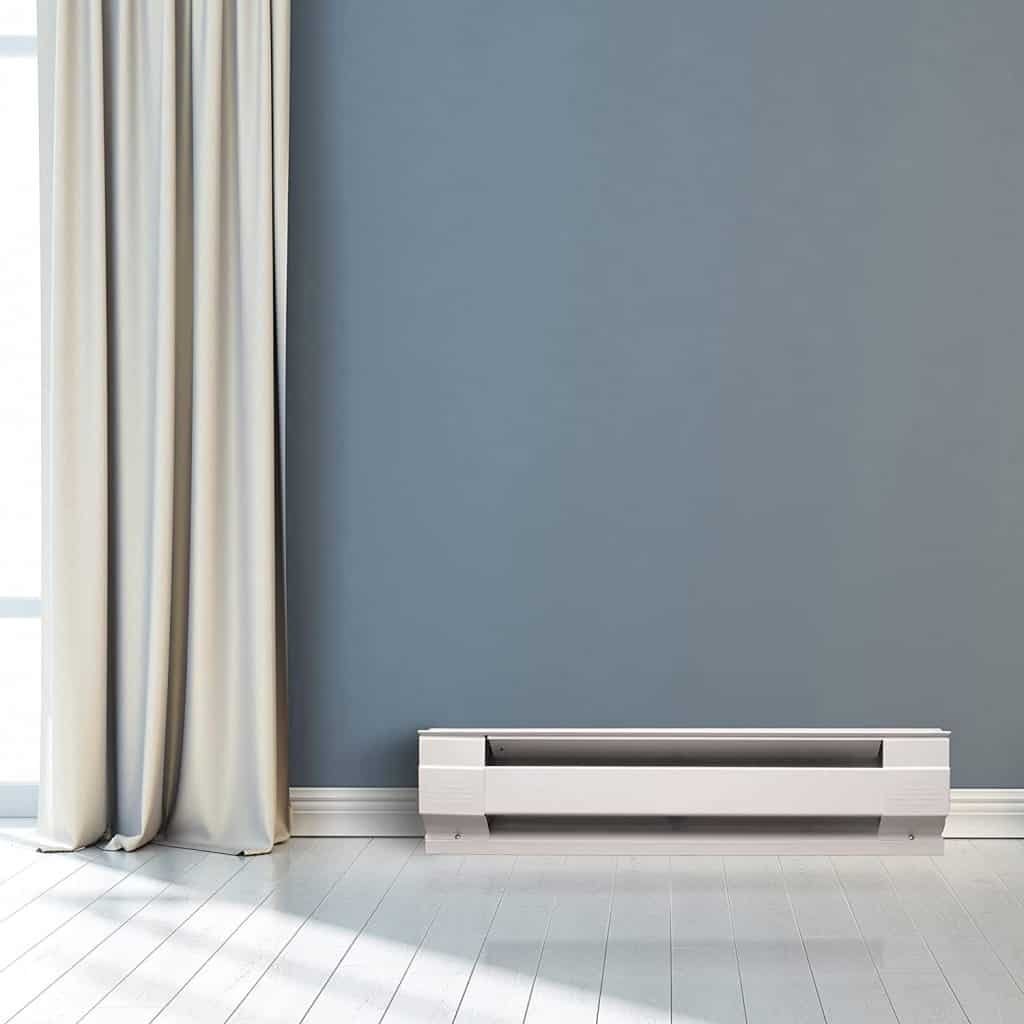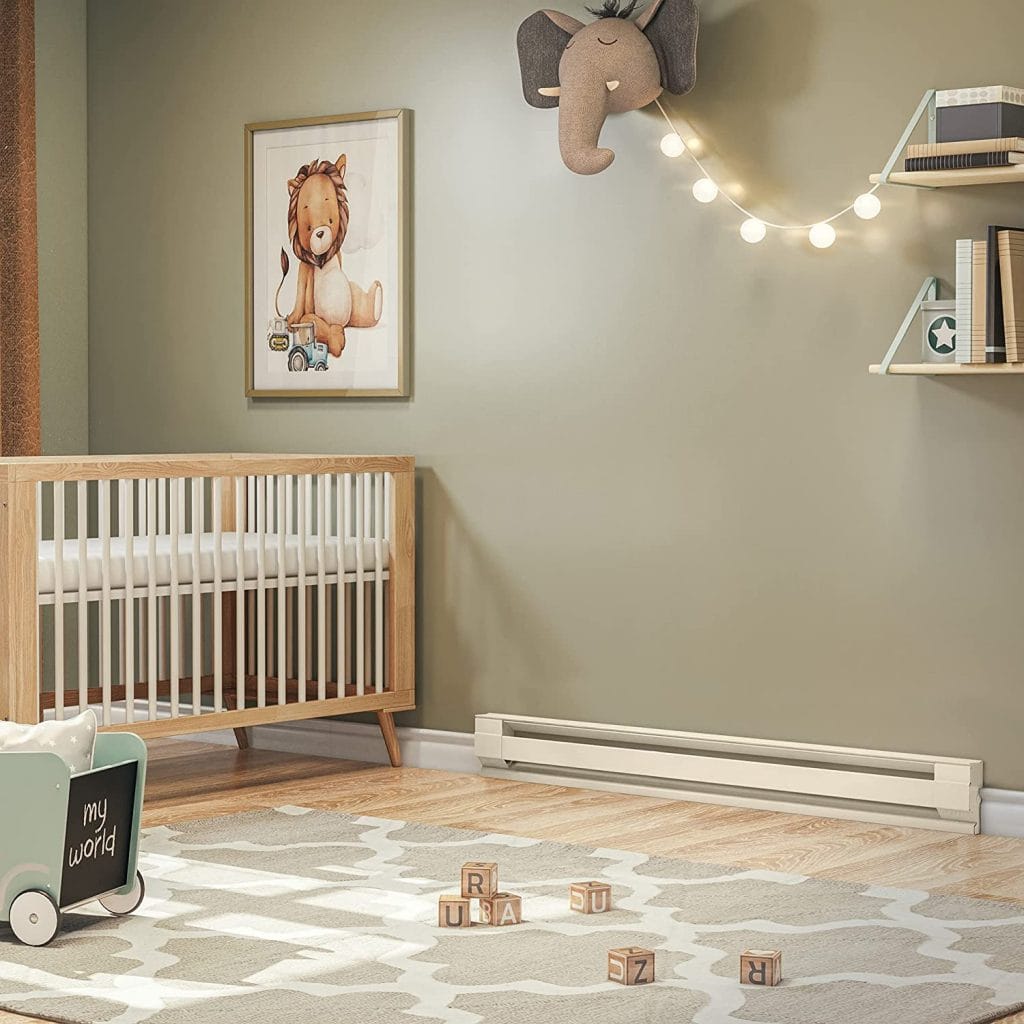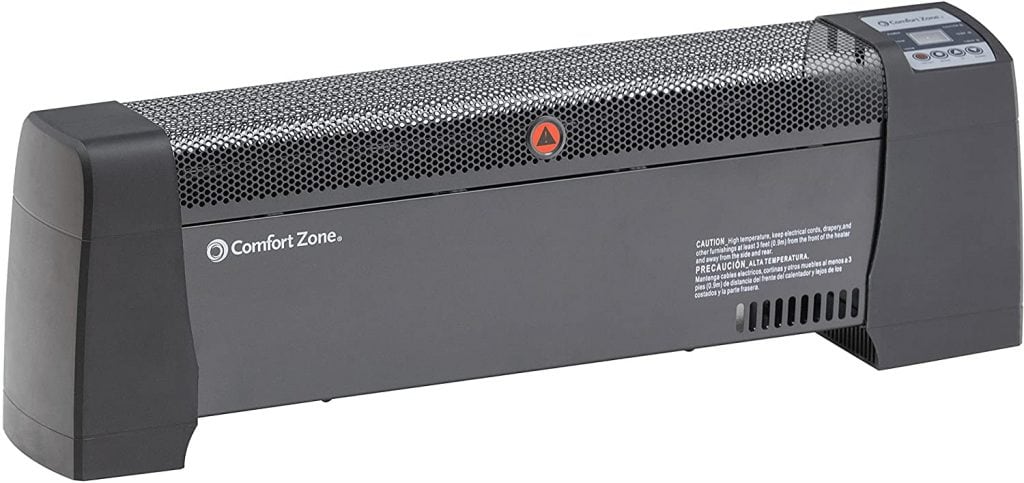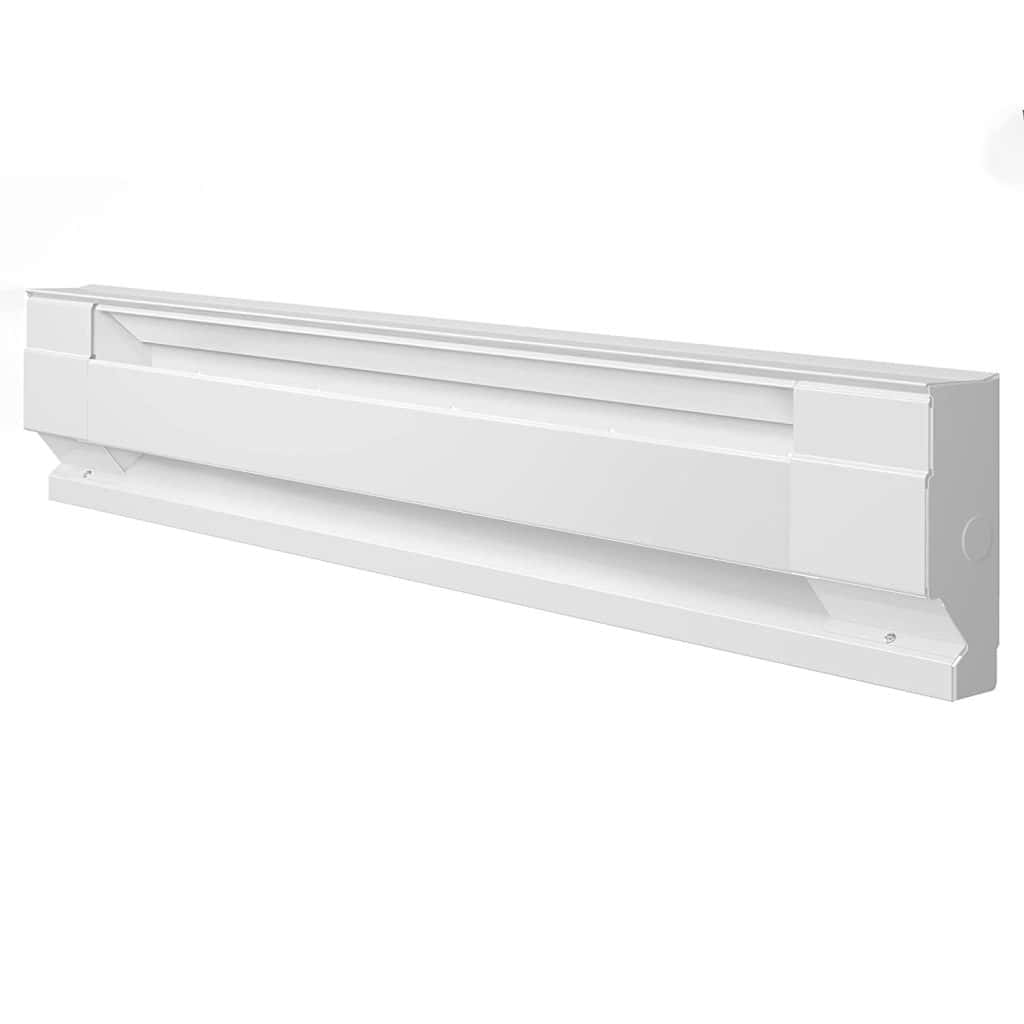Baseboard heaters are the perfect alternative to central heating systems. If you live in an apartment or a small building, baseboard heaters are the obvious option. These small heaters generate enough heat to warm up large rooms in minutes. The heaters tend to be quiet, last easily up to 20 years, and happen to be on the inexpensive side.

Baseboard heaters are primarily available in two types of heat-generating systems; electric and hydronic. Electric baseboard heater heats the room by convection whereas hydronic baseboard heater generates heat by boiling liquid.
Electric Baseboard Heaters
Electric baseboard heaters are the most common type of baseboard heater you will find in most homes. Also known as convection heaters, they collect the cool air that pools close to the floor.
The units have electric coils inside them which heat up when you turn the machine on. The metal fins then heat the cool air and release it as hot air back into the room. This entire process is called convection.

Usually, the electrical heaters are part of the electrical system of a house. However, you can also find units in the market which need to be plugged into an electrical outlet to run.
Electrical heaters come in various sizes and heat-generating capacities. The installation process is simple, the coils heat up super quick and they are supremely affordable.
Yet, running the electric baseboard itself can cost a lot. As the heat spreads quickly when you turn the unit on, it also disappears just as fast if you turn it off. In the winter months, you might have to keep it on for long periods of time. This means your electricity bills are going up.
Electric heaters also have to be paired with a thermostat. It is either available on the heater itself or you can mount one to the wall and connect it to the baseboard heater.
Hydronic Baseboard Heaters
Hydronic baseboard heaters heat up water or boil reserved internally and then distribute the heated condensation into the air to warm the room. The units can be completely self-contained where the coil inside the unit heats up the water.
Hydronic baseboard heaters can also be connected to the central boiling system of a home to have a continuous supply of hot water.

Since hydronic heaters are fluid-based, where either oil or water is boiled to create warm air, the room stays warm even after you turn off the hydronic heater. However, it can take longer for the room to warm up in comparison to electric baseboard heaters.
There isn’t much availability when it comes to sizes and heating capacities either. Hydronic baseboard heaters are the best option when you already have a central boiler and need a system that will heat up the entire house.
In conclusion, hydronic baseboard heaters are more energy-efficient than electric baseboard heaters. You don’t have to keep it running the entire time. They also cost way more than electric heaters, though you can find some less costly models in the market now.
The Differences Between Electric And Hydronic Heaters
Here’s a quick overview of the differences between Hydronic and Electric baseboard heaters;
| Aspect | Hydronic Baseboard Heaters | Electric Baseboard Heaters |
|---|---|---|
| Operation | Boils water to release hot air | Directly heats air |
| Noise Level | Both quiet, occasional ticking | Both quiet, occasional ticking |
| Energy Efficiency | Retains heat longer, more efficient | Less efficient, needs longer run times |
| Cost | More expensive upfront, energy savings | Inexpensive upfront, higher energy costs |
| Lifespan | 10 years with maintenance, corrosion risk | Up to 20 years, low maintenance |
| Maintenance | Annual maintenance required for boiler | Occasional dusting, low maintenance |
| Size Options | Limited size options | Wide range of sizes available |
| Installation | Professional installation recommended | Professional installation recommended |
| Voltage Options | Available in 120V or 240V | Available in 120V or 240V (requires compatible circuit) |
| Safety | Cool to touch, safer for pets and children | Can become hot to touch |
| Clean Air | Releases less dust and allergens | Can circulate dust and allergens |
Hydronic baseboard heaters are more energy-efficient and safer to touch, making them a better choice for households with pets or children. However, they come at a higher upfront cost and require more maintenance. Electric baseboard heaters are less expensive initially but less energy-efficient, resulting in higher operating costs over time. The choice between the two depends on your priorities and needs.
Now let’s compare these aspects in detail;
Noise Level
Both electric and hydronic heaters are quiet in operation. There are no moving elements inside the units, so there is no situation where the machines make noise.
Sometimes, you might hear a tick tick sound on both. This is the thermostat determining the heater is too hot and turning it off for safety reasons. The noise is made due to the electric casing expanding.
Use of Energy
The energy required to spread heat into the room is the same amount for both heaters.
However, electric heaters don’t retain the heat as long as hydronic heaters do. As a result, an electric heater has to be kept on for a long period of time to keep the room warm, thus leading to more use of energy.
It is better to have the thermostat mounted to the wall for this reason. Compared to when it is attached to the baseboard, the thermostat gives a more accurate reading of the room on the wall. If you have to fiddle with the thermostat, it is also easier when it
When it comes to saving energy, hydronic heaters are the clear winners.
Even after the thermostat turns off, the room will stay warm for a long time because the boiled fluid takes longer to cool down. The disadvantage resides in how long it can take for the room to warm up with the hydronic system.
If the hydronic system is self-contained, then you might have to purchase a couple of them and disperse the units throughout the house. These are expensive in that regard but you will save when it comes to energy generation. Hydronic heaters are also expensive due to self-sufficiency.
If the hydronic heater you buy has a central boiling system, purchasing one is enough to heat up the entire house.
Cost
Electric baseboard heaters are generally inexpensive. Only, the advantage is undermined by how energy inefficient they are.
Hydronic baseboard heaters cost 4 times the price of electric baseboard heaters with the same watt generating capacity. You can save up on electricity bills though.
Lifespan
Electric baseboard heaters can easily last 20 years. There is no moving material inside the machine that can suddenly give up on you.
The same applies to hydronic heaters. However, the lifespan can easily be limited to 10 years. Since it has fluids inside, corrosion is a possibility. As such, yearly maintenance is required if you want it to last 20 years.
Maintenance
The most maintenance you need to do with the electric heater is dust up the unit once in a while. There is no fan, no duct, or anything else that might require maintenance or repair.
The same applies to the hydronic heater. Except, since it is a fluid-based system, the boiler chamber has to be maintained every year or so. This is to prevent any chance of corrosion, which can prevent the hydronic heater from working properly.
The maintenance of the hydronic baseboard heater is better left off to a certified repair person.
Size
The electric baseboard heater system has a huge variety when it comes to size. You can find a 20-inch one for an extremely small room as you can find 96 inches or an eight-foot one for a bigger room.
Hydronic baseboard heaters aren’t found that much in the market in general. As a result, the size options are also lower. You can get some from 35 to 94 inches range. Even then, it is a short selection.
Installation
Both types of baseboard heaters can be mounted to the wall and directly connected to the electrical lines in the home. However, this job is better left to professional electricians.
You can also find plug-in models for both types in the market, though these are rare.
The voltage options for both heaters are available in either 120 Volt or 240 volts. If you buy a 240 volt one, you will need a circuit board that can handle 240 volts.
Safety
Hydronic heaters are always cool to the touch. This is advantageous if you have pets or children at home who might bump into electric heaters and burn themselves.
Clean air
Since the hydronic heater is boiling water, there is less dust and allergens in the air. Convection heaters warm up the cool air, which can often contain bacteria, and releases it back into the room.
Which is better?
In the fight between hydronic vs electric baseboard heaters, there is no clear winner. It mainly depends on the type of house and the weather condition in your location.
Electric heaters are easier to maintain but if your house is constantly cold, the ultimate electricity bill can be big. Hydronic heaters are the better option if you already have a central boiling system and would rather spend more at once than over the years.
We have created a tiny list of the best electric and hydronic heaters. Take a look at them to see if you want to bring any of them home.
3 Best Electric Baseboard Heaters
1. Fahrenheat FBE15002 Portable Electric Baseboard Heater
This electric baseboard heater generates 1500 watts and can run on a 120-volt plug. Since this is a plug-in unit, you can move the heater to any part of the room you want to warm the area.

This is a 45 inches long unit, taking up little to no space. The thermostat is built-in, as are the handles. The setup is the easiest part of this heater and it also produces a high level of heat. Only, the lack of a safety screen is a bit concerning.
Best features:
- Portable design.
- Overheat protection.
- Built-in thermostat.
- Small size.
2. Cadet F Series 36 in. Electric Baseboard Heater
The Cadet F series electric baseboard heater is about 36 inches long, making it one of the smallest options on the market. It is perfect for a small room. It generates about 750 watts on a 120-volt plug.
It is pre-punched so while installation process is relatively easy. All the items needed for installation comes with the package, except for the thermostat, which you will have to buy separately.
There is a safety shut-off for a high-heat situation.
Best features:
- Powder-coated for scratches.
- Automatic shut-off on overheating.
- UL listed.
- Easy wiring on all ends.
3. Comfort Zone® Digital Baseboard Heater
This is one of the most innovative electric baseboard heaters available on the market.

There are two wattage options of 1500 and 750. There is a digital control panel which allows you to choose. This also might be the smallest model in the market with its 10 inches size.
You can plug it into any outlet and even time how long the heater would run. Regardless, the auto shut-off system turns it off if it gets too hot. All this for an extremely low price.
Best features:
- Digital control.
- Auto on and off of thermostat.
- Overheat protection.
3 Best Hydronic Baseboard Heaters
1. Fahrenheat PLF Liquid Filled Electric Hydronic Baseboard Heater
The Hydronic baseboard heater from Fahrenheat is about 46 inches long.

There is flexibility in the installation option as you can mount it to a wall, tile, wood floor or even carpet. The heater automatically shuts off if the air intake section is blocked, thus reducing the chance of fire erupting.
Best features:
- Cool to touch.
- Overheat on and off safety features.
- Easy installation.
- Welded grille for good air flow.
2. Fahrenheat PLF1504 Liquid Filled Hydronic Baseboard Heater
Another hydronic-based heater from Fahrenheat, this one is 70 inches long.

This isn’t portable so you have to hardwire it. The heater runs on 240 volts and produces 1500 watts of heat. It’s enough to heat up big rooms for a long period. The thermostat is pre-installed on the unit.
Best features:
- Pre-installed thermostat.
- Continuous, stable heat.
- Remains cool.
- Noiseless.
3. Marley HBB1254 Liquid Filled Electric Hydronic Baseboard Heater
Even though this is a hydronic electric heater, this one needs a plugging outlet to run.

It is 58 inches long, making it the ideal size. It has to be plugged into a 240-volt circuit and can produce 1250 watts of heat continuously.
The heat will remain long after the heater has been turned off for safety reasons.
Best features:
- Quick heater despite being hydronic based.
- Automatic safety shut off in case of overheating.
- Easy installation.
- Safe for pets and children.
Final Words
Whether an electric baseboard or a hydronic baseboard heater is better depends on your home and personal preferences. However, you should always measure the room you are buying the heater for to make sure a single unit would generate enough heat.


Comments are closed.